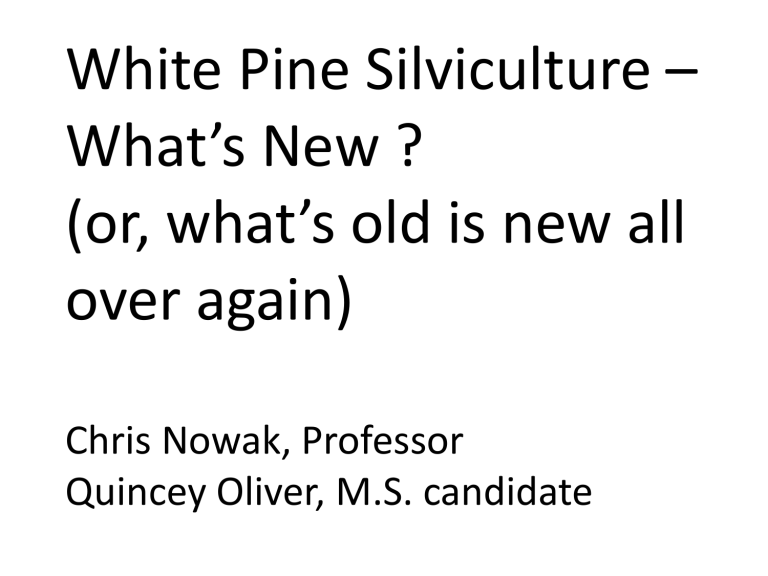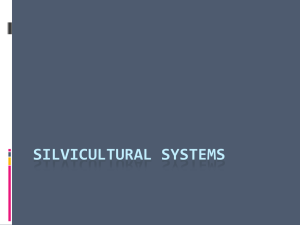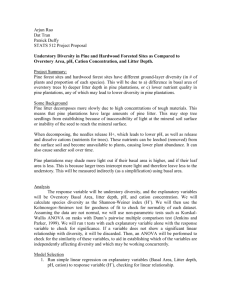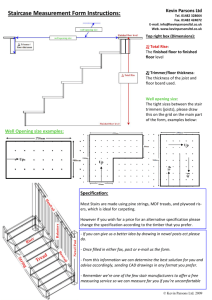White Pine Silviculture – What’s New ? over again)

White Pine Silviculture –
What’s New ?
(or, what’s old is new all over again)
Chris Nowak, Professor
Quincey Oliver, M.S. candidate
BIOTIC FACTORS
Associated plants and animals
Competition
Facilitation
Herbivory—mammal, insect
Predation—seed, seedling
Pathogens
The Plant Ecology “Diamond”
SPECIES LIFE HISTORY
Allocation to reproduction, growth, & maintenance
Growth/development rates
Longevity
Reproductive strategy
Propagule type, dispersal, availability
Competitive ability
Site tolerances
Plant /
Plant
Community
ABIOTIC FACTORS
Soil
Texture, nutrients, drainage
Physiography
Landform, parent material, slope position, aspect
Water
Climate
Light and temperature
Disturbance
Type
Frequency
Timing
Intensity
Space Availability/Niches
SILVICULTURAL SYSTEMS* – white pine
Regeneration of white pine
• Clearcutting, strip cutting, seed-tree cutting and shelterwood cutting
– Two-cut shelterwood is deemed most successful
• 1 st cut: immediately after an abundant seed year (a cardinal rule)
• Remove 40 to 60 percent of overstory
• Disturb accumulated litter and expose mineral soil
• Remove advance hardwood regeneration
• Remove other hardwoods (other interfering plants?) before the overwood removal
• Direct seeding? Planting?
• Site considerations ?
*NOTE: these are convention for high quality sawtimber production
*NOTE: all being tested as part of current R&D program After Lancaster and Leak (1978)
Silviculture to maintain white pine is complex, difficult, and intensive
HWF
PACK
Polymorphic site index curves for white pine
(Parresol and Vissage 1998) showing HWF and PACK stands.
Silviculture to maintain white pine is simple, easy, and extensive
COMPLEX to SIMPLE
(or, “Give up” to
“Take what you can get”)
HIGH QUALITY SITE SILVICULTURE: Finessing and managing white pine into the future stands
Regeneration research (ESF)
- Shelterwood for refined attention to relative stand density control
- Direct seeding (w/wo scarification)
- Planting (w/wo scarification)
- Interfering plant control (field trip)
Tending (Literature, University of Maine, ESF – growth and yield)
- Release (field trip)
- Thinning – crop tree versus area-wide
HIGH QUALITY SITE SILVICULTURE: Finessing and managing white pine into the future stands
Regeneration research (ESF)
- Shelterwood for refined attention to relative stand density control
- Direct seeding (w/wo scarification)
- Planting (w/wo scarification)
- Interfering plant control (field trip)
Tending (Literature, University of Maine, ESF – growth and yield)
- Release (field trip)
- Thinning – crop tree versus area-wide
Challenges in the high quality site on the
Huntington Wildlife Forest
Looking into the uncut control plot on the Huntington Wildlife
Forest stand, circa 2012.
Light levels too low at ground-level
- 2012 Shelterwood: 20 vs 40 RSD
Removal of hardwood understory
Scarification
No advanced regeneration, and offyear for natural seed supply
- Artificial regeneration
Direct seeding
Planting
“The” Experiment
Split-split plot completely randomized design
Whole plot: Site
HWF vs PACK
(high vs low)
Subplot: Overstory treatment
20 % RSD 40 % RSD
Scar 2
Sub-subplot: Understory treatment (completely randomized)
Unscar 2
Scar1
Unscar 1
Unscar 1
Scar 2
Scar 1
Unscar 2
Source of variation
Replicates (Rep)
Site
Site*Rep
Overstory Treatment
(OTRT)
Site * OTRT
Site*Rep*OTRT
Understory Treatment
(UTRT)
Site*UTRT
OTRT*UTRT
Site*OTRT*UTRT
Error
ANOVA example
Degrees of freedom
1
1
1
1
1
1
1
4
1
1
2
P-value
0.16
0.22
0.69
0.18
0.03
0.71
0.43
0.29
0.17
0.31
Direct Seeding
“The Result”
25.0
20.0
HYP: 20 = 40 w/HWF
P-value = 0.18
HYP: 20 = 40 w/PACK
P-value = 0.03
15.0
10.0
5.0
0.0
Rep: 1 2 1 2 1 2 1 2 1 2 1 2 1 2 1 2
Scarification: Y Y N N Y Y N N Y Y N N Y Y N N
Overstory Treatment:
(% RSD) 20 40 20 40
Site:
Huntington Forest Pack Forest
Shelterwood cut at Pack Forest, circa Spring 2013.
Old versus new
CONVENTION
Shelterwood – 2-stage
1 st cut high RSD with scarification to promote germination and establishment (Lancaster and Leak
1978; Burgess and Wetzel 2002;
Dovciak et al. 2003), following by a reduction in RSD to promote growth and development of established seedlings while tempering interspecific plant competition and weevil damage; overstory removal when desired level of advance regen developed; weeding / cleaning as needed
Seed spot at HWF, circa Spring 2013.
Newly germinated seedling, circa Spring 2013.
This is what is new
NEW DISCOVERY
Shelterwood
LOW QUALITY SITE
Follow convention
HIGH QUALITY SITE
1 st cut low RSD to promote germination and establishment; else, follow convention
? Scarification ?
? Direct seeding – yes ?
? Release treatment ?
Planting
“The” Experiment
Split-split plot completely randomized design
Whole plot: Site
HWF vs PACK
(high vs low)
Subplot: Overstory treatment
20 % RSD 40 % RSD
Scar 2
Sub-subplot: Understory treatment (completely randomized)
Unscar 2
Scar1
Unscar 1
Unscar 1
Scar 2
Scar 1
Unscar 2
Jiffy-Tubed Seedlings
“A Result”
Rep: 1 2 1 2 1 2 1 2 1 2 1 2 1 2 1 2
Scarification: Y Y N N Y Y N N Y Y N N Y Y N N
Overstory Treatment:
(% RSD) 20 40 20 40
Site:
Huntington Forest Pack Forest
HIGH QUALITY SITE SILVICULTURE: Finessing white pine into the future stands
Regeneration research (ESF)
- Shelterwood for refined attention to relative stand density control
- Direct seeding (w/wo scarification)
- Planting (w/wo scarification)
- Interfering plant control (field trip)
Tending (Literature, University of Maine, ESF – growth and yield)
- Release (field trip)
- Thinning – crop tree versus area-wide
Huntington stand history
350
18
16
14
12
10
40 %
20 %
0
0
C
B
TREES PER ACRE
8
A
700
Seymour et al.’s low density thinning
350
18
16
14
12
10
8
A
0
0
C
B
TREES PER ACRE
700
Seymour et al. (2006)
Huntington versus Seymour et al.
350
18
16
14
12
10
8
A
0
0
C
B
TREES PER ACRE
700
Seymour et al. (2006)
Wood production – tradeoffs with tending
0 %
Generalized after: Leak 1981, 1982,
2003; Guiterman et al. 2011
Relative Stand Density
100 %
TENDING tradeoffs continued
CROP TREE
• HIGH live crown ratio (+)
– Increased red knots (+)
– Fast individual tree growth (+)
• LOWERED stand-level wood production (-)
AND:
Unplanned regeneration (?)
Interfering plants
Problems with wind firmness (-)
AREA-WIDE
• LOW live crown ratio (-)
– Increased black knots (-)
– Modest individual tree growth (o)
• MODERATED stand-level wood production (o)
AND:
Little unplanned regeneration
(?)
Little problem with wind firmness (+)
SEE: Leak (1985) for a direct discussion on this matter.
IDEA (*NEW): The “Nowak” variants
350
18
16
14
12
10
8
A
0
0
LQ
HQ
C
B
TREES PER ACRE
700
Your own choices and variants ????
White Pine Ecology and
Silviculture
SUMMARY
SILVICULTURAL SYSTEMS* – white pine
Regeneration of white pine
• Clearcutting, strip cutting, seed-tree cutting and shelterwood cutting
– Two-cut shelterwood is deemed most successful
• 1 st cut: immediately after an abundant seed year (a cardinal rule)
• Remove 40 to 60 percent of overstory
• Disturb accumulated litter and expose mineral soil
• Remove advance hardwood regeneration
• Remove other hardwoods (other interfering plants?) before the overwood removal
• Direct seeding? Planting?
• Site considerations ?
*NOTE: these are convention for high quality sawtimber production
*NOTE: all being tested as part of current R&D program After Lancaster and Leak (1978)
SILVICULTURAL SYSTEMS* – white pine
Tending of white pine
• Area-wide thinning
– B-line level residual
• Use of stocking chart
• Release ?
• Pruning ?
*NOTE: these are convention for high quality sawtimber production
*NOTE: not currently being tested as part of current R&D program After Lancaster and Leak (1978)
What’s New ?
(or, what’s old is new all over again)
Thank you !
To the field … (after lunch)






